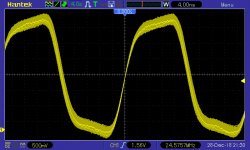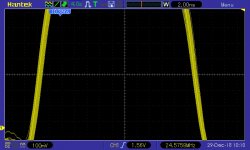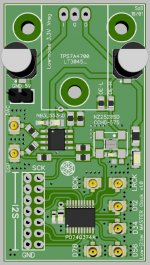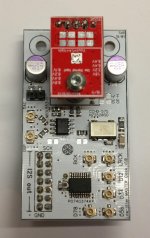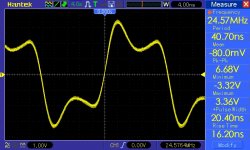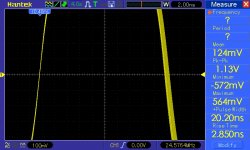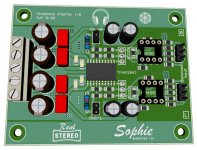Last edited:
Looks noisy, and almost like scope probe could be out of calibration. Any idea why the noise? Does the wave shape change at all when you move the scope probe ground lead around?
@zarandok
Also, how much bandwidth does your oscilloscope have? Are you using your probe set to "x10"?
Also, how much bandwidth does your oscilloscope have? Are you using your probe set to "x10"?
So, I have my winter-project...🙂
Quite impressive!! The potato chip is a good choise imo.
I'm considering what other clocks can be use with my Si5xx footprint, perhaps design an universal pattern. But the NDK clocks are simply too small, unfortunatelly not possible if I don't want to get a short with the bigger 6 pin examples. Alternatives are the Crystek C33xx and CCDH-575 models, they have about the same size, but only 4 pads.
The Si clocks have relativ high phase noise, and are sentitive to the power supply (experience of Ian) regardless to the good PSRR value. That's why I thinking about alternatives....
Can't you change the PCB footprints anymore in the design for the NDK? These are cheap and very good.
I've made new measurement with calibrated scope and other earth point. Seems to be a little better...
The probe is set up to "10x", scope bandwith is 100Mhz.
I can change the footprint but I have than no compatibility with Si oscillators. (Crystek has 4 pins so it is ok) That's the choice....
The probe is set up to "10x", scope bandwith is 100Mhz.
I can change the footprint but I have than no compatibility with Si oscillators. (Crystek has 4 pins so it is ok) That's the choice....
Attachments
Does look much better. However, can't really measure jitter accurately with most scopes.
What kind of clock do you have now, and is it on its own dedicated voltage regulator? If already ultra-low jitter rated clock and dedicated regulator, probably not going to get a whole lot better. If not either, then going to Crystek (especially with its own voltage regulator located nearby on the same ground plane) would probably make it about as good as you are likely to get.
Other things can matter too, such as having a good ground plane at all, having the clock output loading within specs, etc.
What kind of clock do you have now, and is it on its own dedicated voltage regulator? If already ultra-low jitter rated clock and dedicated regulator, probably not going to get a whole lot better. If not either, then going to Crystek (especially with its own voltage regulator located nearby on the same ground plane) would probably make it about as good as you are likely to get.
Other things can matter too, such as having a good ground plane at all, having the clock output loading within specs, etc.
I've a MiniDSP USBStreamer. I have no idea what voltage regulator it has, there is e.g. one TPS7A4700 on board but I don't know what it supplies. The jitter performance is anyway not good. See for example this topic: Master clock and isolator for the MiniDSP USBStreamer
Great work! Did you tried your DAC with nanoSHARC as source?
I started similar project but with AK4490 and I wanted to make 4 same boards and use them with nanoSHARC... For now I made one board and testing it in stereo mode...
I started similar project but with AK4490 and I wanted to make 4 same boards and use them with nanoSHARC... For now I made one board and testing it in stereo mode...
Is the CCHD-575 crystal 5V tolerant?
Not according to the data sheet. Probably unwise to try pushing beyond what the manufacturer states as limits.
D
Deleted member 537459
Is possible have pcb dac and pcb ouput stage, i allready make a project with 3 different 9038qm2 chinese dac on my panasonic ub9000. Now i mount ian's mcfifo and i search pcb dac all stuff with lifepo4 current. Fortunetly i finder this thread!!
Hi reggieSf25,
which board, DAC or clock pcb? How do you mean "controlled freq and timing"?
There is an active filter modul what makes a low-pass filtering and output buffering.
If you want more you need a DSP to control these parameters.
which board, DAC or clock pcb? How do you mean "controlled freq and timing"?
There is an active filter modul what makes a low-pass filtering and output buffering.
If you want more you need a DSP to control these parameters.
pls note that most AKM dacs need to be kickstarted by pulsing the PDN pin.
I do this using a logic port on the dsp,sadly these dacs cannot start on their own.
I do this using a logic port on the dsp,sadly these dacs cannot start on their own.
- Home
- Source & Line
- Digital Line Level
- AK4458 multichannel DAC with I2S input
